
The History of Trentino begins in the mid-Stone Age and continues to the present day when Trentino is part of the Italian Republic. [1]

The History of Trentino begins in the mid-Stone Age and continues to the present day when Trentino is part of the Italian Republic. [1]
During the Stone age the valleys of what is now Trentino were already inhabited by humans, the main settlements being in the valley of the Adige River, thanks to its milder climate. Research suggests that the first settlers (probably hunters) came from the Padana Plain and the Venetian Prealps, after the first glaciers began melting at the end of the Pleistocene glaciations.
Findings (in particular, burials) from the Mesolithic period have been found in several parts of the province. These include the comuni of Zambana and Mezzocorona. A large area of a hunting-based settlement from the Neolithic period has been found near the lakes of Colbricòn, not far from the Rolle Pass.
Around 500 BC, the Raetians appeared in the Trentine area, coming from the Central and Eastern Alps area. They settled in several valleys and brought new skills on top of the traditional hunting: agriculture (grapes, vegetables, cereals), breeding (ovines, goats, bovines and horses). During the Roman Age, part of the current Trentino-Alto Adige/Südtirol region made up the province of Raetia.
This region was totally conquered by the Romans in the 1st century BC. The definitive defeat of the Rhaetians, near Bolzano, occurred during the military campaigns in the Alps of Drusus and Tiberius (16-17 BC). Trento became a Roman municipium in the 40s BC. During the reign of Emperor Claudius (41-54 AD) Trentino was integrated into the Imperial road network with the construction of the Via Claudia Augusta Padana (from Ostiglia to the Resia Pass) and the Via Augusta Altinate (from Treviso to Trento, passing through the Valsugana). Claudius also issued an Edict, contained in the Tabula clesiana , which extended Roman citizenship to the residents of this region. By the fourth century the area was fully latinisated.

During the Late Antiquity, in the 5th century AD, Trentino was invaded several times, from North and East: first by the Ostrogoths, then by the Bavarians and Byzantines and finally by the Lombards. With the latter's domination, an idea of the territorial identity of the province began to take shape (Tridentinum territorium). In the same century, the region became largely Christianized. In 774 Trentino was conquered by the Franks and became part of the Kingdom of Italy, a sometimes vague entity included in what was to become the Holy Roman Empire.
The first territorial unity of Trentino dates back to 1027, when emperor Conrad II officially gave the rule of the area to the Bishopric of Trent. This entity survived for some eight centuries and granted Trentino a certain autonomy, first from the Holy Roman Empire and then from the Austrian Empire.
In the early 19th century some of the Trentine people participated actively in the resistance, led by the Tyrolean Andreas Hofer, against the French invasion.
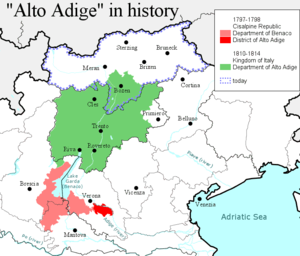
Napoleon created in 1810 the Department of Alto Adige that included most of actual Trentino and the area around Bolzano in Alto Adige. It was part of Napoleon's Kingdom of Italy for some years.
After the end of the Napoleonic era (1815), the Bishopric of Trent was dissolved and Trentino became part of the County of Tyrol, in which the majority of the population was German-speaking. Though relatively well administered, and despite the presence of Trentine representatives in the Diets of Innsbruck and Vienna, in the second half of the 19th century a movement (part of the general movement called Italian irredentism) arose with the aim of annexing all the region (south of the Alps watershed) to the Kingdom of Italy: this, however, was largely put forward by intellectuals like Cesare Battisti and Fabio Filzi, and met some support by the predominantly rural population.
Given the area's strategic importance in the event of a war between Austria-Hungary and Italy, the Austro-Hungarians strengthened their troop levels there and fortified the area in the early twentieth century. Under the authority of the Austro-Hungarian chief of staff Franz Conrad von Hötzendorf, modern, armored fortifications were built in the areas around Lavarone and Folgaria; their dual purpose was to protect against an Italian attack and to secure the area as a staging ground for an Austrian assault on Northern Italy. [2]
After Italy entered the First World War in 1915, the Trentine territory was an important front between Italy and Austria-Hungary, and suffered heavy destruction. After the call to arms summoned by Emperor Franz Joseph I of Austria on 31 July 1914, more than 55,000 Trentini fought for Austria, first against Russia and Serbia and, starting from 1915, also against Italians. Despite the fact that they were fighting against Italian soldiers (Trentini soldiers spoke Italian) desertion cases were extremely low. [3] More than 10,000 of them died, and many others were wounded or made prisoners. [4] Further, hundreds of thousands of civilians were forced to abandon their native area when they were too near to the front lines. Many of them, captured by the Italian Army, were later transferred to Southern Italy as colonists.
With the Treaty of Saint-Germain (1919), Trentino was united to Italy, together with the new Province of Bolzano/Bozen (South Tyrol), as part of Venezia Tridentina. The centralization process brought on by the Fascists reduced the autonomy that cities like Trento or Rovereto had enjoyed under the preceding Liberal governments, while many of the smaller comuni were united, reducing their number from the 366 under the Habsburg to 127.

After World War II, the treaty signed by the Italian and Austrian Ministers of Foreign affairs, Alcide De Gasperi and Karl Gruber, the autonomous Region of Trentino-Alto Adige/Südtirol was created (see Gruber-De Gasperi Agreement).
In the following decades the main party in Trentino was the Christian Democracy, while autonomistic instances found their voice in the Partito Popolare Trentino Tirolese (Trentine-Tyrolese Popular Party). In 1957 strife between Trentino and the largely German-speaking South Tyrol led to the popularity of the slogan Los von Trient ("Away from Trento"). In 1972 the regional administration was handed over to the two provinces.
In the 1960s and 1970s Trentino witnessed strong economic development, spurred mainly by the tourism sector and by the new autonomy. It is currently one of the richest and best developed Italian provinces.
In 1996, the Euroregion Tyrol-South Tyrol-Trentino was formed between the Austrian state of Tyrol and the Italian provinces of South Tyrol and Trentino. The boundaries of the association correspond to the old County of Tyrol. The aim is to promote regional peace, understanding and cooperation in many areas. The region's assemblies meet together as one on various occasions and have set up a common liaison office to the European Union in Brussels.
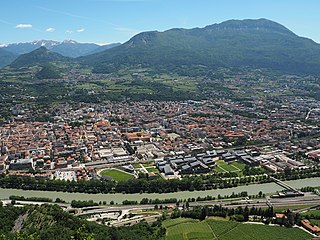
Trento, also known in English as Trent, is a city on the Adige River in Trentino-Alto Adige/Südtirol in Italy. It is the capital of the autonomous province of Trento. In the 16th century, the city was the location of the Council of Trent. Formerly part of Austria and Austria-Hungary, it was annexed by Italy in 1919. With 118,142 inhabitants, Trento is the third largest Italian city in the Alps and second largest in the historical region of Tyrol.

The history of Tyrol, a historical region in the middle alpine area of Central Europe, dates back to early human settlements at the end of the last glacier period, around 12,000 BC. Sedentary settlements of farmers and herders can be traced back to 5000 BC. Many of the main and side valleys were settled during the early Bronze Age, from 1800 to 1300 BC. From these settlements, two prominent cultures emerged: the Laugen-Melaun culture in the Bronze Age, and the Fritzens-Sanzeno culture in the Iron Age.
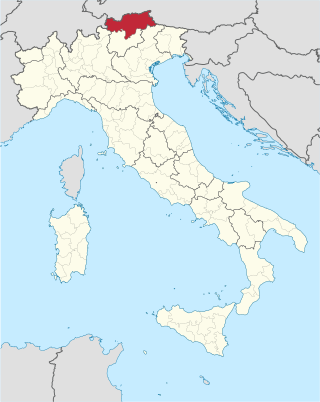
South Tyrol is an autonomous province in northern Italy. An English translation of the official German and Italian names could be the autonomous province Bolzano – South Tyrol, reflecting the multilingualism and different naming conventions in the area. Together with the autonomous province of Trento, South Tyrol forms the autonomous region of Trentino-Alto Adige/Südtirol. The province is the northernmost of Italy, the second largest with an area of 7,400 square kilometres (2,857 sq mi), and has a total population of about 534,000 inhabitants as of 2021. Its capital and largest city is Bolzano.

Trentino-Alto Adige/Südtirol is an autonomous region of Italy, located in the northern part of the country. The region has a population of 1.1 million, of whom 62% speak Italian as their mother tongue, 30% speak South Tyrolean German and several foreign languages are spoken by immigrant communities. Since the 1970s, most legislative and administrative powers have been transferred to the two self-governing provinces that make up the region: the province of Trento, commonly known as Trentino, and the province of Bolzano, commonly known as South Tyrol. In South Tyrol, German remains the sizeable majority language.
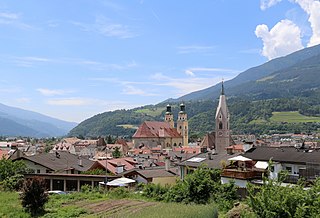
Brixen is a town and commune in South Tyrol, northern Italy, located about 40 kilometres (25 mi) north of Bolzano.
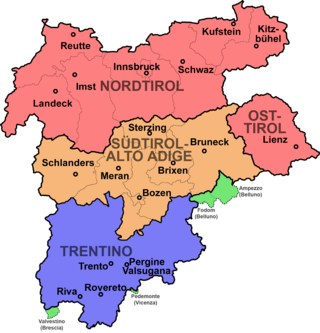
East Tyrol, occasionally East Tirol, is an exclave of the Austrian federal state of Tyrol, separated from North Tyrol by parts of Salzburg State and parts of Italian South Tyrol. It is congruent with the administrative district (Bezirk) of Lienz.

Provincia autonoma di Trento, commonly known as Trentino, is an autonomous province of Italy in the country's far north. Trentino and South Tyrol constitute the region of Trentino-Alto Adige/Südtirol, an autonomous region under the constitution. The province is composed of 166 comuni. Its capital is the city of Trento (Trent). The province covers an area of more than 6,000 km2 (2,300 sq mi), with a total population of 541,098 in 2019. Trentino is renowned for its mountains, such as the Dolomites, which are part of the Alps.

Modern-day South Tyrol, an autonomous Italian province created in 1948, was part of the Austro-Hungarian County of Tyrol until 1918. It was annexed by Italy following the defeat of the Central Powers in World War I. It has been part of a cross-border joint entity, the Euroregion Tyrol-South Tyrol-Trentino, since 2001.

The (Princely) County of Tyrol was an estate of the Holy Roman Empire established about 1140. After 1253, it was ruled by the House of Gorizia and from 1363 by the House of Habsburg. In 1804, the County of Tyrol, unified with the secularised prince-bishoprics of Trent and Brixen, became a crown land of the Austrian Empire. From 1867, it was a Cisleithanian crown land of Austria-Hungary.

Luserna is a comune (municipality) in Trentino in the northern Italian region Trentino-Alto Adige/Südtirol, located about 25 kilometres (16 mi) southeast of Trento. As 2021, it had a population of 271 and an area of 8.2 square kilometres (3.2 sq mi).
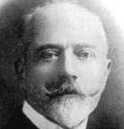
Ettore Tolomei was an Italian nationalist and fascist. He was designated a Member of the Italian Senate in 1923, and ennobled as Conte della Vetta in 1937.
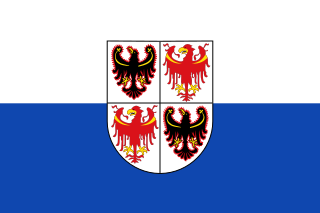
The Politics of Trentino-Alto Adige/Südtirol takes place in a framework of a parliamentary representative democracy, whereby the President of Regional Government is the head of government, and of a pluriform multi-party system. Executive power is exercised by the Regional Government and Legislative power is vested in both the government and the Regional Council. However, since a constitutional reform in 1972, almost all the executive and legislative powers are devolved to the two provinces of which the region is composed: Trentino and the South Tyrol.

The Tyrol–South Tyrol–Trentino Euroregion is a Euroregion formed by three different regional authorities in Austria and Italy: the Austrian state of Tyrol and the Italian autonomous provinces of South Tyrol and Trentino.

Tyrol is a historical region in the Alps of Northern Italy and western Austria. The area was historically the core of the County of Tyrol, part of the Holy Roman Empire, Austrian Empire and Austria-Hungary, from its formation in the 12th century until 1919. In 1919, following World War I and the dissolution of Austria-Hungary, it was divided into two modern administrative parts through the Treaty of Saint-Germain-en-Laye:
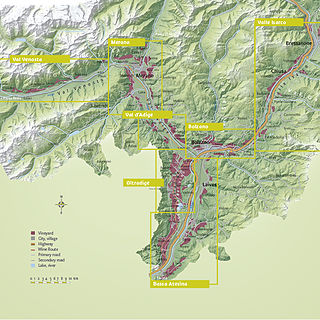
South Tyrol is an autonomous province located in northeast Italy producing wine. This Austro-Italian wine region is noted for the distinct Austrian influences on the wine industry, due to the region's long history under the rule of Austria-Hungary and Holy Roman Empires.
Mediocredito Trentino – Alto Adige is an Italian investment bank based in Trento, Trentino. The bank served historically the autonomous provinces of Trentino and South Tyrol, but now extended to Lombardy (Brescia), Veneto and Emilia-Romagna (Bologna).
The following is a timeline of the history of the city of Bolzano/Bozen in the Trentino-South Tyrol region of Italy.

The flag of Trentino-Alto Adige consists of a coat of arms, containing two eagles of San Venceslao (Trentino) and two Tyrolean red eagles, historical symbols of the two provinces, which stand out against a white and blue background. The shape of the flag is a rectangle with a framed heraldic shield on it. Like other flags, the flag of Trentino-Alto Adige is also inspired, albeit differently, by the French flag introduced with the revolution of 1789. When Napoleon's army crossed Italy, starting from March 1796, flags of tricolour style were adopted both by the various newborn Jacobin republics and by the military units that supported the French army. In the Alpine region, however, sketches of the two-tone known today began to emerge. Trentino-Alto Adige has been a region with a special statute since 1948. The two parts that make it up, the Province of Trento and the Province of Bolzano, in turn, constitute two provinces with particular prerogatives of autonomy defined in 1972. The white-blue flag, in use (limited) since 1995, takes up the characteristics of the banner, including the shield with quartered eagles from the province of Trento and that of Bolzano. White and blue are the colours on which the coats of arms of Trento and Bolzano respectively were worn in ancient times. It has never been legally defined, unlike the coat of arms and the banner, approved on 17 September 1982 and approved by presidential decree of 21 March 1983.

Luigi Carbonari (1880–1971) was an Italian politician from Trentino who was active in the agricultural cooperative movement.